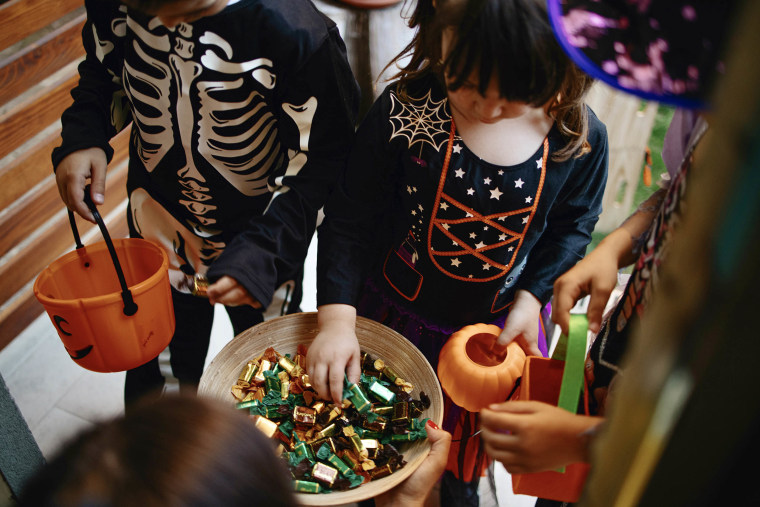For all the worry about poisoned candy on Halloween, there’s little evidence that any child has died from tainted treats after trick-or-treating in the U.S., except for one documented case — and the father did it.
In fact, warnings about razor blades, needles and deadly chemicals lurking in children’s Halloween candy abound. But how often does it actually happen? Pretty rarely, according to experts.
This month, the U.S. Food and Drug Administration issued a press release encouraging parents to “inspect commercially wrapped treats for signs of tampering, such as an unusual appearance or discoloration, tiny pinholes, or tears in wrappers. Throw away anything that looks suspicious.”
The federal agency tells TODAY.com that while the problem is not widespread, "The FDA issues these yearly Halloween safety tips out of an abundance of caution to remind parents and consumers to remain vigilant during this time of year. While there are fortunately no specific incidents of tainted Halloween candy to point to, the FDA has received reports of 'copycat' products that appear to be candy that contain substances that are inappropriate for children."
Not all warnings are a precautionary measure — in 2022, police in Eugene, Oregon say, people found razor blades “hidden” in Halloween candy and they investigated three reports. "Although investigators worked the case thoroughly, we did not find a suspect in these unfortunately," a police spokesperson tells TODAY.com. [
In 2021, the Fostoria Police Department in Ohio offered to X-ray Halloween candy after a KitKat bar and a package of Sour Patch Kids distributed during a city trick-or-treating event had been poked with sewing needles.
Hysteria over tampered Halloween treats is overblown, according to Joel Best, a professor of sociology and criminal justice at the University of Delaware. Best has been spearheading research about poisoned Halloween candy — aka, "Halloween sadism" — since 1985.
"I knew a folklorist ... who was born in the ‘30s, and she reported hearing stories about people who would keep pennies on a skillet, and then pour hot pennies into the outstretched hands of trick-or-treaters,” Best told TODAY in 2022. “The worry that somebody might be contaminating treats has been around for a while. It picked up speed in the 1960s, and by the late 1960s, it was pretty well-embedded.”
"I have data going back to 1958 ... and I cannot find a single case of a child killed or seriously injured by a contaminated treat picked up in the course of trick-or-treating,” he added.
As Best points out on his website, "A basic logical principle is that one cannot prove a negative. Therefore, I can never prove that no child has been killed by a Halloween sadist. I can simply note that such a death probably would be a major news story, yet I can’t find any evidence of such a story being covered by major media."
One case bears mentioning, and it hits close to home.
In 1984, a Texas man named Ronald Clark O’Bryan was convicted and executed for killing his 8-year-old son Timothy by lacing his Halloween candy with cyanide, after taking out life insurance policies on both of his children. O'Bryan also placed cyanide into the candy of other children, per court documents, but they did not die as a result.
O'Bryan became known as "The Candy Man" and "The man that ruined Halloween for the whole world."
“It profoundly affected the whole community, every child of trick-or-treating age,” said Mike Hinton, a former Harris County prosecutor involved in the trial, according to the Washington Post. "There’s no question it had a national effect on Halloween."
So, besides those jump scares, what's actually to fear on Halloween?
Theft and vandalism
Theft on premises and vandalism increases on Halloween, by 11% and 68%, respectively, according to 2022 data from Travelers Insurance. That includes stolen Halloween decorations, a popular target of theft.
Food allergies
The Teal Pumpkin Project raises awareness about children's food allergies by displaying a blue pumpkin anywhere candy is distributed on Halloween.
As Dr. Clifford W. Bassett, author of "The New Allergy Solution" previously told TODAY.com, kids with allergies (and their parents) should be vigilant on Halloween, reading ingredient list on candy packaging carefully and avoiding treats that, for example, "may contain nuts” or were “made in a facility that contains nuts."
Late-night trick or treaters
Whether teens are too old to trick-or-treat is a matter of opinion; however, kids of any age can cause mischief on Halloween. Most people agree that trick-or-treating hours are anywhere between 6 p.m. and 9 p.m. If you're worried about kids ringing your doorbell late at night, turn off your lights or hang a sign that lets people know the fun is over.
